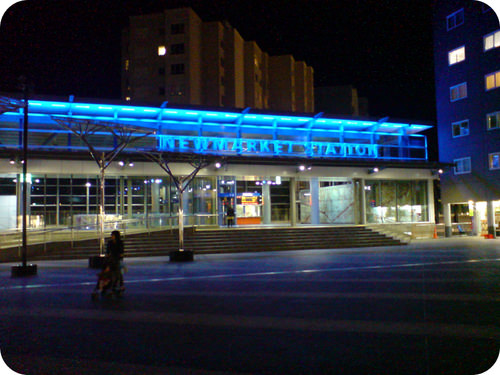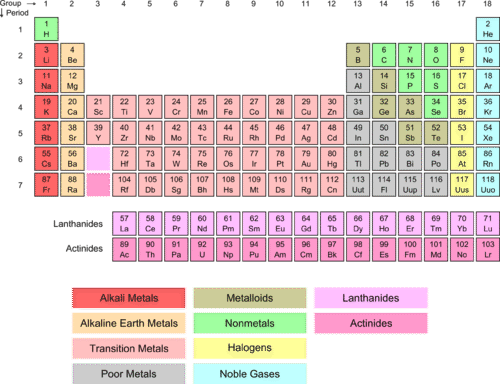6.11 惰性气体
章节大纲
-
What gives these lights their color?
::这些灯是什么颜色的?Cities at night would be rather boring without all the bright lights. They provide colorful Illuminations and help make things much more visible. We call these lights “neon lights,” but they use several to make the different colors.
::城市在夜晚没有灯光就会变得无趣无趣。 它们提供多彩的照明,帮助让事物更加可见。 我们把这些灯光称为“新光 ” , 但它们使用几种来制造不同的颜色。Noble Gases
::惰气体The reactivity of an can give us important clues as to the electron configuration of that material. If an element is extremely unreactive, this suggests that the electron configuration is such that adding or removing electrons is very unlikely. There must be a stable electron configuration that resists further reaction.
::一种电能的回动能为我们提供有关该材料电子配置的重要线索。 如果一个元素极不活跃, 这表明电子配置非常不可能添加或删除电子。 必须有稳定的电子配置来抵制进一步的反应 。The Group 18 (once known as group VIII) elements are essentially chemically inert (light blue column on the right). All these elements exist as monatomic gases at room temperature . If we look at the configurations, we see that helium ( 2) has a full shell of two s electrons. Since there are no electrons shielding this shell from the nucleus , these two electrons will be very difficult to remove, making helium unreactive.
::第18组(原称为第八组)元素基本上是化学惰性(右侧的浅蓝色柱),所有这些元素在室温温度下都作为门形气体存在。如果我们看一下这些配置,我们就会发现(2个)的外壳有2个电子。由于没有电子将这个外壳从核中屏蔽出来,这两个电子将非常难以去除,使氦失去反应能力。The remaining elements in the group have full outer shells consisting of two s electrons and six p electrons for an outer shell content of eight electrons. This particular arrangement renders the atoms fairly unreactive. This group has been referred to as the “inert” gases, indicating that they are chemically inert, or unreactive. Another popular term is “ noble gases ,” suggesting that these gases do not like to have much to do with the other, more common materials (or that they don’t do a lot of work).
::该组的其余元素有全部外壳,由两个电子和六分电子组成,用于八种电子的外壳内容。这种特殊安排使得原子相当不活跃。 这个组被称为“内脏”气体,表明它们化学上是惰性或不活跃的。 另一个流行的术语是“无害气体 ” , 表明这些气体不喜欢与其他更常见的材料有太多关系(或者它们不做很多工作 ) 。Noble Gas Compounds
::惰性气体化合物In more recent years, a number of reactions using the noble gas elements have been discovered. Although the conventional wisdom was that the complete outer shells of these elements would not allow them to react, some scientists believed that the outer electrons of the larger elements (such as Rn, Xe, and Kr) were far enough away from the nucleus that they should be able to be displaced under the right set of conditions. The first (XePtF 6 ) was made with xenon in 1962. Since then, several compounds have been made with radon, xenon, krypton, and argon. Only helium and neon have not formed compounds at this time.
::近年来,发现了一些使用惰性气体元素的反应。虽然传统智慧是这些元素的完整外壳不允许它们作出反应,但一些科学家认为,较大元素(如Rn、Xe和Kr)的外电子离核足够远,因此它们应该能够在正确的条件下迁移。第一种(XePtF6)是1962年用xenon制成的。从那时以来,已经用、xenon、Krypton和Argon制成了若干化合物。目前只有和还没有形成化合物。Colors of Noble Gases
::惰气体颜色The different gases glow when an electric current is passed through them. Many of these gases are used in displays because of their chemical inertness. They are stable and will not react with other materials in the system . Radon also will give a reddish glow, but is not used because it is radioactive and will not retain its structure as radon for any significant length of time.
::当电流经过时,不同的气体会发光。其中许多气体由于化学惰性而被用于显示器中。这些气体是稳定的,不会与系统中的其他材料发生反应。 Radon也会发红色发光,但不会被使用,因为它是放射性的,不会在任何相当长的时间内保持其结构为。Royal Society of Chemistry - Colors of the Noble Gases
::皇家化学学会 -- -- 惰性气体的颜色Science Friday: 4850 Feet Below: The Hunt for Dark Matter
::科学星期五:4850英尺以下:猎杀黑暗物质Why is there a laboratory 4850 feet below the surface? It turns out the depth is a necessary component of the extremely sensitive detector called the Large Underground Xenon . In this video by Science Friday, several scientists explain how this detector helps physicists look for extremely rare particles.
::为何在地表下有4850英尺的实验室?结果显示深度是叫做大型地下Xenon的极敏感探测器的必要组成部分。在科学周五的这段视频中,几位科学家解释了该探测器如何帮助物理学家寻找极为罕见的粒子。Summary
::摘要-
The noble gases are in group 18 (once known as group VIII) of the periodic table.
::惰性气体为周期表第18类(原称为第八类)。 -
Helium has a full outer shell of two
electrons.
::氦的外壳有两颗电子 -
The other gases have full outer shells of two
and six
electrons.
::其他气体的外壳满是两S和六p电子。 -
Compounds have been formed with Rn, Xe, Kr, and Ar.
::化合物由Rn、Xe、Kr和Ar组成。
Review
::回顾-
What elements comprise the noble elements?
::何为崇高要素? -
What state are they in at room temperature?
::室温是什么样的状态? -
Why is helium non-reactive?
::为什么没有反应? -
Why were the other noble gases believed to be non-reactive?
::为什么其他惰性气体被认为没有反应? -
When was the first compound formed from xenon?
::第一个化合物是什么时候由xenon形成的? -
What happens when an electric current is passed through these gases?
::当电流穿过这些气体时会怎样?
-
The noble gases are in group 18 (once known as group VIII) of the periodic table.


